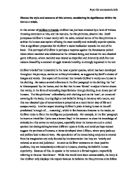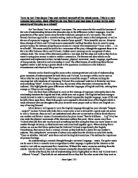Graphic and harsh language permeates the whole of this first section of the chapter creating a highly effective image of the squalor in which the Mohammedan Indians are condemned to live by their English rulers. The streets are “Mean” the “Temples ineffective” and the “Filth” of alleyways deters all but the invited guest.” By describing their quarter in such a way Forster makes the Muslim Indian seem almost sub-human to his readers, this of course, is how they are viewed by the English. They are remarked upon as “Low” but also as “Indestructible.” Despite their apparent lack of sophistication, the way in which, “The general outline of the town persists” comes to reflect the similar way in which the Muslim culture, although suppressed by the English, is based upon strong foundations of religious devotion and an inextinguishable spirit. Forster describes them as “Swelling here…shrinking there” and by doing so creates a very evocative image which captures perfectly the way in which the Indian race move ‘en-mass’ and in harmony, united in their angst to recapture their homeland.
As Forster remarks, “Inland the prospect alters” and the Eurasian, Anglo-India described in the second section of the passage could not present a more stark contrast to that of Islamic Chandrapore. Here the houses belonging to the Eurasians “Stand on high ground” an important symbol which reflects the way in which the English believe themselves to be above the Indian race both morally and intellectually. It is this attitude of ignorance and racial superiority which will be developed and scathingly criticised by Forster as the novel progresses. Indeed it could be argued that humanity’s unwillingness to understand one another is the underlying theme behind the whole text and that in reality Adela and Mrs. Moore’s passage to India is in fact a deeper analogy for a more complex passage of mankind towards understanding itself.
On a second rise of land lies the “Little civil station.” As the focal point for Eurasian society it is remarked that, “From here...Chandrapore appears to be a totally different place.” This observation encapsulates the way in which the station and its social club both seem to be isolated from the rest of India. Immersed in a fantasy world of British high society the station itself is described as, “Provoking no emotion” and “Sensibly planned.” This epitomises the logical mindset of the English, which deeply contrasts that of the spiritual Indian and highlights how even at a simple level of human understanding harmony is not possible between the two cultures creating the “Muddle” which is colonial India. Britain’s attitude of imposing herself upon other nations, typical of this time period before partition, is something heavily attacked by Forster. Throughout the text he is seen to criticise England replicated in India because to him this is unnatural and false.
During the entirety of this second section of the passage Forster adopts a tone of negativity towards the English. Their section of Chandrapore is described as, “Sharing nothing with the rest of the city except the overarching sky” conveying the way in which they consciously isolate themselves from the Indians. In the overall context of the novel this image becomes very important. As gradually relations between the two races come to deteriorate the sky comes to be the only unifying element between Indian and Englishman. Further more, the way in which the image is echoed throughout the text seems to suggest the existence of a more powerful presence beyond man both physically and in terms of significance within the universe. It is Forster’s belief that ultimately the petty quarrels of man are meaningless in such a vast entity.
The final section of the chapter is used by Forster to expand on the concept of the overarching sky. It is described as having a “Persistent blue core” the stars “Hanging like lamps from the immense vault” which is the sky and it is elevated imagery such as this which comes to symbolise a hope for the future of mankind. In contrast to the “muddle” and “misunderstanding” which covers India and the rest of the earth, the sky instead represents an element which unifies all men. Its persistence represents a hope that one day all the problems of man explored within the novel will pale into insignificance. It could be argued the description of the sky evokes an atmosphere akin to that of the Hindu religion. Forster remarks, “The sky settles everything” and indeed to Godbole and his fellow Hindus this is to a certain degree true. The unanswerable questions, the answers to which are sought by both Muslim and Christian are left to be pondered by Godbole. He seeks to answer questions about his own spiritual existence and the natural world around him. As a result his passage within the novel becomes one of progression as opposed one to of retreat as is experienced by Aziz and Fielding.
The Chapter ends with a final short image of the mysterious Marabar caves. All around “League after league the earth lies flat,” yet in the south, “A group of fists and fingers are thrust up through the soil.” These fingers are the ‘Marabar hills’ and seem to point mysteriously towards the heavens above. The way in which they seem to separate themselves from their earthly surroundings suggests an equally unearthly presence about them. This of course will be proved true by the supernatural and inexplicable violation which Adela experiences within their walls. Dark and devoid of humanity they represent an aspect of India that the logical English will never be able to conquer.
Therefore it is possible to conclude that the first Chapter of ‘A Passage to India’ can be regarded as a template for the novel as a whole. Almost all of Forster’s overall concerns are indicated by its content and it is clear that the varied description of the Indian landscape comes to symbolise differences between those who inhabit the land. This disjointed construction of society will only increase as the novel progresses ultimately leading to the personal retreat of the novel’s two main characters, Aziz and Fielding whom are unable to stand out as individuals and trapped within the confines of their own cultures. It will be only the deeply spiritual Godbole who is shown to have made any real progress via his own ‘Passage to India’ and of course Mrs. Moore, who despite her death becomes a symbol for hope by the way in which she is revered as a Hindu Goddess.
Bibliography
“A Passage to India” - E.M. Forster
Classic notes -







